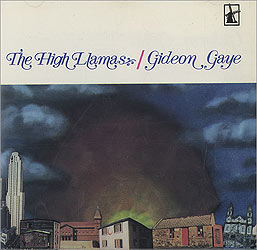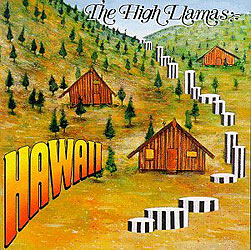Painters Paint: The Definitive Career-Spanning Interview (to date) With The High Llamas’ Sean O’Hagan
Published on January 30th, 2011 in: All You Need Is Now, Current Faves, Interviews, Issues, Music |Popshifter: 1994 then ushered in the Golden Age (if that’s not too strong) between The High Llamas and V2 (Virgin’s now apparently-defunct subsidiary label). I refer to it as a Golden Age, simply because I recall you had a wonderful marketing/publicist rep who generously gave out Llama-related promotional freebies; you might feel differently. But anyway, how did that union come about?
Sean O’Hagan: Jeremy Pearce set up V2 records on request from Richard Branson. He had run a very successful independent division of Sony for years, signing Suede and Oasis. He signed us to Sony after seeing the band perform as Love with Arthur Lee in London. We performed an orchestrated Love set, comprising Forever Changes and Da Capo. Arthur had never heard these songs live as he had recorded them. It was an amazing experience. Jeremy was there and saw the High Llamas play a Llamas set then and signed us. There were a lot of labels chasing the band by then.

He set up V2 with us and then signed Mercury Rev. Jonathan and Sean from Mercury Rev used to visit us in London when they were around; we loved them and they loved Gideon Gaye. It was a great time.
Popshifter: The album that makes the “big splash,” is Gideon Gaye and this seems to be the one where you began to get burdened with The Beach Boys tag by music journalists who would not actually listen to the records that came after this. I enjoy this album because it seems to be a bridging work: it’s got a foot in the camp of Santa Barbara with the acoustic guitars and then it’s got a foot in the future (where Hawaii would venture). There’s a (forgive the word) quirky determination on this record—backwards tape loops, an homage to Brian Wilson’s “George Fell Into His French Horn,” etc. You’re doing things on this record that were just so far from what everyone else was infatuated with. Can you speak to the making of Gideon Gaye and how you followed your Muse down this particular path?
Sean O’Hagan: I had been working with Stereolab for two years and made Space Age Bachelor Pad Music. Making this record convinced me that quick, loose, impulsive recording had the advantage over balanced overworked, safe recording. I was infatuated with the gothic oddness of California and Yes, so I wanted to represent it in rain-sodden, clunky London. I wanted the exotic trip of imagery to grace the dark London club stages.
Charlie Francis recorded the record that we made in two to three-quarter day stints for Andy Stark’s Target label in Brighton. This was before Jeremy Pearce (V2/Sony) had seen us. We had the record recorded before he signed us.
We worked in a great little studio called the Stone Room in West London. Again we were drunk on experimentation: wheeling in rank pianos, recording impossibly thin buzz guitars, and for the first time I was experimenting with string writing. As the ideas fell upon themselves, and it all worked, the architecture of the band just started to build itself before us. And in my mind, I saw Hawaii happening as we were recording Gideon Gaye.
It was also only six years since Microdisney ended, which was by then ’80s pop machine gloating and wrong. Gideon Gaye was small, dry vocals, tapestry-like, ornate, mad, and all happening at a quick pace. No aching or pondering, just decisions. It was all so clear. And no one else was anywhere near attempting what we had achieved. I had also realized that the raw beauty of drum machines sat incredibly well with this vision and a drop of Kraut rock just served to draw the record away from homage to self-ownership.
Popshifter: Two years later in 1996, you delivered the epic Hawaii. There’s something sharply Technicolor about this album in comparison to everything that came before. From inception to completion, how long did it take to make Hawaii?
Sean O’Hagan: I think I wrote Hawaii in six months and we took three months to record.
Popshifter: There’s such cohesiveness to this record that I have to ask: Was there ever a moment where you had any doubts about the direction? There seems to be an air of happiness and playfulness surrounding Hawaii.

Sean O’Hagan: By then I was listening to free jazz as well as Gene Clark and Mancini and Morricone. They all had to be there on the record [in spirit], driving a new music that seemed so obvious but hitherto had never been represented. I had a vision of Carla Bley giving way to the creaking, reverbed upright music hall pianos, and the melancholy of Italian soundtracks giving way to the clumsy chuggings of Nue and Cluster or Holger Czukay. We were fortunate enough to have the best London jazz guys who now wanted to be on our records, and string players who were classically trained and totally on board.
Again, Charlie Francis recorded the record and we owe a lot to his dedication and total commitment to what we wanted to achieve.
I remember it being a hardworking, exciting time. Fun but serious work. We were totally in pursuit of something of our own, with a lot of instinctive decisions that were easy to make.
Popshifter: One of the remarkable things that you brought into the Hawaii fold was your use of instrumental tunes, like “Sparkle Up.” I am genuinely fascinated by what motivated you to add instrumentals. “Sparkle Up” definitely adds to the cinematic, Fantasia-like feel, but I would like to get your take.
Sean O’Hagan: Instrumentals were a natural progression from Santa Barbara through Gideon Gaye to Hawaii. It was almost a statement, us forcing a new pop upon people, or even an old pop if you take the A&M heritage of instrumental music into consideration. I also wanted our voices to take a step back into the brotherhood of sound and arrangement, as our voices were part of the picture, not the feature. We almost wanted our audience to understand chords and harmony as we did. We were saying, “Come on, just listen and understand the arrangement with us. Enjoy it.”
Click to read more about . . .
Santa Barbara
Gideon Gaye and Hawaii
Cold and Bouncy and Lollo Rosso
Snowbug and Buzzle Bee
Beet, Maize & Corn, Can Cladders, and the upcoming Talahomi Way
8 Responses to “Painters Paint: The Definitive Career-Spanning Interview (to date) With The High Llamas’ Sean O’Hagan”
January 31st, 2011 at 10:10 am
An amazing interview.. thank you so much!
January 31st, 2011 at 12:33 pm
Wow! Awesome job! We’re kindred souls. Like you, I have loved the High Llamas since the release and discovery of “Hawaii.” Thoroughly enjoyed your interview; you asked many of the questions I’ve had for years…and does it ever have me stoked for April 11.
January 31st, 2011 at 1:19 pm
I’ve passionately loved the Llamas ages! It amazes me how much of their music I’ve still not heard; I got stuck on Cold and Bouncy and hardly budged. It’s one of my examples of a completely perfect record. Love this interview!
February 2nd, 2011 at 12:39 pm
Big Llamas fan here, very happy to get such in-depth insight into Sean’s relationship with his work. I had the pleasure of seeing Sean and the band play a show around Christmas at a town hall north of Camden after the release of Hawaii, and I have fond memories of the show, which was spectacular. I hope to see them again!
February 2nd, 2011 at 5:58 pm
Thank U Thank U Thank U for this! Fantastic interview…Bravo. The passionate few of the world are still here – living each day with an appreciation for the Llamas that grows and with continued hope for their successful return. The next couple of months will be sweet agony.
BTW – I saw the HL show at the Black Cat in 2004, haven’t been back there since.
February 11th, 2011 at 7:11 am
All Llamas fans will surely get a big kick out of the new Ocean Tango album, which is actually a collaboration between Louis Philippe and the excellent Swedish band Testbild! Sean is a big fan of both and even gets to play on the album, which can be found at http://oceantango.bandcamp.com. Needless to say, the British media have so far given it a wide berth . . . sigh . . .
February 14th, 2011 at 2:21 pm
Great interview. For a “non-college” guy, Sean is certainly articulate and thoughtful in his speech and music. I liked how he said “Snowbug” was his favorite Llamas album, because it is now my favorite, even though I have only it owned it for a month. The fade-out to “Go To Montecito” could go on all night and I would never stop grooving to it…never heard any of the post-Snowbug albums but I will get to them all, I know. Thanks Sean, for such sublime music. Hope you can get to America and tour again…saw you in Pontiac, MI at a club show in the late 90s….can’t remember what year exactly.
September 19th, 2012 at 8:01 pm
[…] Again we were drunk on experimentation: wheeling in rank pianos, recording impossibly thin buzz guitars, and for the first time I was experimenting with string writing. As the ideas fell upon themselves, and it all worked, the architecture of the band just started to build itself before us. (read the whole interview with Sean O’Hagan by John Lane). […]
Time limit is exhausted. Please reload the CAPTCHA.